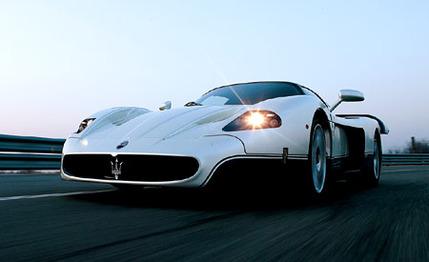 First Drive Review
First Drive Review
The high-speed test track at the Fiat Group's Balocco proving ground near Milan, Italy, is an asymmetrical trioval with long straights and slightly banked corners. It's a confusing layout in a flat landscape that provides few visual reference points. Not surprisingly, at a recent press introduction, Maserati's technical staff felt compelled to install several cone chicanes to slow the progress of the company's MC12 supercar before it reached the bends. You know, lest it shoot off at triple-digit velocities into the surrounding brush.
It seemed like a good idea, given the way in which this 624-hp spyder (it has a removable hardtop) gobbles space. With the driver doing little but pressing the accelerator and tugging at the gearshift paddles behind the steering wheel, the MC12's Ferrari Enzo-derived 6.0-liter V-12 frequently hit the rev limiter-at 7700 rpm-in first and second gears before the drivers realized how fast it uses up the lower gears.
We soon got used to the V-12's glorious exhaust twang and harmonic crescendo that warns of imminent rev-limiter intervention. It's necessary, because you don't want to take your eyes off the track too long in this baby. The quarter-mile comes and goes in just over 11 seconds, and the needle swings to 270 km/h (168 mph) easily before the next forbidding row of cones streams into view, signifying that it's time to slow down.
With big 15.0-inch cast-iron Brembo rotors up front pinched by six-piston alloy calipers and 13.2-inch rotors inside four-piston calipers in the rear, slowing isn't a problem. The braking power is enormous. What is a problem is the pad material chosen for this roadgoing version of an FIA GT and/or American Le Mans race car. To provide immediate cold-brake response and squeal-free operation for everyday driving, the MC12 has Pagid street pads. When you apply repeated braking from over 150 mph to 30 mph to negotiate the cone chicanes, then add a couple of day-job automotive writers whose bumper stickers read I'd Rather Be Racing, you have a recipe for fire in the wheel wells. And by that I mean real flames licking up from the pads.
Out in the real world, you'd be unlikely to encounter this problem. It's simply a part of the compromise necessary to turn a car designed around FIA/ALMS regulations into a relatively usable street ride. Those regulations steered a design concept originated by Giugiaro to fully formed race and street MC12s whose final shapes and trappings were penned and selected by designer Frank Stephenson.
The result is this swoopy sliver with its long-nose, long-tail shape born of hours in the wind tunnel and repeated reference to the racing rulebook. Hence the forward-mounted radiators and their upper-surface outlets. On the road car, these are covered by longitudinal strakes to maintain the aperture sizes necessary to prevent the accidental ingestion of small pedestrians.
At the rear, there's a wing spoiler mounted low across the tail, its outboard fixture points cantilevered beyond the sides of the rear bodywork to allow the mirrors a decent shot back down the road. There's no rear window, because a roof-mounted air-induction snorkel and its giant plenum use up all the real estate. The mirrors are all you have to check behind you.
Among the compromises made in the name of racing, interior space escaped the worst of them. There's ample head- and legroom for drivers the wrong side of six feet and 34 inches of inseam length, which is a welcome touch in a street-legal projectile like the MC12. And the interior is pretty lavish for a composite car with carbon and Nomex honeycomb-sandwich load-bearing structures. The cockpit surfaces are a mix of carbon fiber, perforated leather, blue plastic moldings, and an interesting textile material that resembles carbon fiber but is soft and yielding to the touch.
The steering wheel is a stylish piece with a flattened carbon-fiber top segment, and it guides the front wheels with a directness that is as remarkable for its integrity as it is for its immunity to kickback shock. Even at very high speed, when an occasional crevice in the oval track at Balocco transmitted a hammer jolt into the pushrod front suspension, that spike of energy would read as just a brief nudge at the wheel.
With plenty of anti-dive, anti-squat, and roll restraint dialed into the chassis, body motions are tautly arrested, yet the ride didn't seem too brutal on either the oval or the old, original Alfa Romeo handling track we were permitted to negotiate. The limits are high on the MC12, and even our most adventurous corner exploits-given no time to learn the course-produced little more than a brief squirm under power from the big 345/35ZR-19 rear Pirelli P Zero Corsa tires. Bosch's traction-control system helps here, although it can also be disabled.
Turn-in felt as if the car were on rails, benefiting from being mid-engined as much as having sticky 245 cross-section Corsas on the front end. The track genes are inescapable here. Big power, good grip, and tons of aerodynamic downforce (the car has two undertail diffusers) speak of the car's real intent. So do its zero luggage space and its rarity (just 25 were built in 2004-all blue and white-and only another 25 are scheduled for 2005). Then there's the price: about $810,000. You'd be extremely lucky to get one, and luckier yet if you could find a use for it that justified its acquisition.